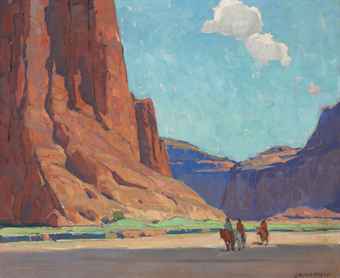There have been times when I have seen the work of an artist that I know is supposed to be great, and despite this knowledge, have found myself underwhelmed. When I first saw the work of John Singer Sargent and Joaquin Sorolla, for instance, I was thoroughly unimpressed. Sargent and Sorolla are now two of my favorite painters, but I was not ready to fully appreciate them when I first saw their paintings. I don’t know what changed or when, exactly, but I eventually found myself skipping class so I could go to the Metropolitan Museum of Art and spend more time viewing the work of these two artists.
I had a similar experience with the work of Edgar Payne. I first saw his work at the Irvine Museum about a year ago. Though I liked his paintings very much, they did not make too much of an impact at the time. But last weekend, I made a trip up to LA to see the retrospective of Howard Terpning’s work at the Autry National Center, and since I was in the area, went to see an exhibit of Edgar Payne’s work currently on view at the Pasadena Museum. My second exerpeience of seeing Payne’s work in person was a revelation to me; I could not believe how simple, yet perfect, his landscapes are.
A lot of Payne’s paintings actually looked pretty disapointing up close, to be honest, but they are incredibly effective when viewed from about five to ten feet back. The water in this painting, for instance, seems to glow from across the room. I loved the colors of the rocks, as well. Payne painted them with bright oranges and reds. He seemed to prefer placing tiles of rich color next to each other on the canvas rather than mixing them on his palette.
I love the bold, squared off brushstrokes in this painting. It’s amazing that it can look so abstract close up and yet look nearly photographic from a few feet back. I think Payne achieved this effect, at least partially, though his control of value. Payne created atmospheric perspective in this landscape by lightening value and greying the color as the trees recede into the distance, which mimics how the human eye would actually see this scene in real life. This is enough to create a remarkably convincing and beautiful image without any fussy detail.
Payne’s greatest strength is his composition, which is not surprising when you consider that he literally wrote the book on it. This painting is a great example; I love how the curve of illuminated rock leads your eye to the pirates camping on the beach. The dark rock in the foreground completes a circle that leads your eye back around again. Payne was very fond of pirates, which just makes me like him more.
Payne’s incredible, stupid simple drawings are my new obsession. I’ve done my share of outdoor sketching, though it’s not usually very enjoyable for me. I always struggle with finding the right shapes and the right composition and the right values and keeping everything simple. Payne’s outdoor sketches are direct and honest. He didn’t seem to erase much, and he didn’t fuss around with any details that were not absolutely necessary for the drawing.
I have to admit, I was not too terribly excited to see this show at first, but I’m so glad I did. Landscape has never been very interesting to me, for whatever reason, but I found Payne’s work to be incredibly moving and beautiful. His precise composition and immaculate color harmonies really had an impact on me. I’ll be studying Payne’s work more in the future to try to learn as much as possible from this great artist.















